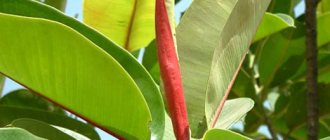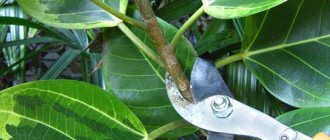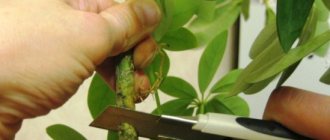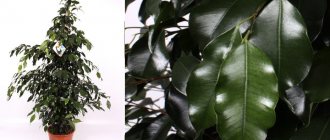Beneficial features
In addition to the fact that rubber is extracted from this plant, ficus is also considered the most useful flower, which can significantly improve the health of the air. This happens because air passes through the leaves like through a pipe. During this passage, it is significantly enriched with oxygen.
Another important advantage is the ficus’s ease of care.
When grown at home, it practically does not bloom, is not capricious and can adapt to absolutely any conditions. The only thing is that the plant needs to be kept away from direct sunlight, watered and bathed on time and in the right amount.
How to properly pinch at home?
In order for the procedure to be successful, the owner of the ficus needs to know the following:
- It is important to choose the right time for pinching. Otherwise, the plant can easily die.
- Ficus juice is poisonous and can cause burns or allergic reactions. Therefore, all manipulations with the plant must be carried out with gloves.
- It is better not to combine pruning with another procedure, for example, replanting.
Ficus can be easily pinched at home if you follow the established rules.
Timing for the procedure
Experienced gardeners know that the ideal time to pinch out ficus is spring. It is during this period that the plant becomes active, forming new shoots and buds. Therefore, the procedure will not be too stressful for the flower, and all “wounds” will heal quickly.
Important! Pinching in autumn or winter can lead to the death of the ficus.
Pinching Instructions
Before you start forming the crown, you need to decide on the choice of knife. It should be sharp enough to cut thick branches straight away. The knife must be disinfected with alcohol or peroxide. If the plant is young, then unnecessary shoots can simply be cut off.
But if the ficus is already several years old, then you need:
- determine the point that will become the top;
- the cut should be made at a distance of 6–8 cm from the sheet;
- branches should be cut obliquely;
When pinching, it is necessary to rinse all cut areas with water. Since the sap of the plant will slow down the growth of new shoots. To form an ideal crown, pinching and pruning should be done annually.
Important Rules
The procedure for forming a crown largely depends on what the gardener wants to achieve. For example, to obtain the shape of a standard tree you need:
- Choose a young, unformed ficus without lignification.
- Then gradually remove the side shoots until 5 top branches remain.
- When the ficus reaches the required height, the top shoot should be pinched and the side shoots removed.
- For young stems without bark, you need to build a support. It will be needed until the ficus finally grows.
Such a standard can be multi-tiered. To do this, the crown is divided into 4–5 parts. The odd ones will be the crown tiers, and the rest will be the spaces between them. To form the latter, shoots are cut 5–7 cm shorter than in tiers.
In addition to the standard, there are several other ways to design a beautiful crown. This is a bush and an arc. To form the first type, it is important to ensure that the ficus does not grow upward, but produces lateral shoots. This is controlled by pinching the flower annually.
The arch is created very simply - the upper part of the plant is bent and fixed at the required height. The upper buds begin to produce new shoots, making the plant more voluminous. As soon as the side shoots reach the desired length, the fixation is removed. The branches of the ficus will remain in the same position, forming an interesting arc.
Further care
After the stress suffered due to the procedure, the ficus needs additional feeding. It is added immediately or wait 1-2 weeks until the plant adapts. If necessary, you can transplant the ficus into a new pot. This is true for plants that no longer fit in the old container.
Rubber-bearing ficus, how to make it lush. How to prune ficus correctly?
Ficus pruning can be carried out in two directions: improving the health of the plant and making it more decorative. Health pruning is carried out in order to:
- rejuvenate the plant;
- prevent his baldness;
- remove diseased shoots.
Decorative pruning solves the following problems:
- form a crown;
- make the ficus branch in the right place;
- get rid of dry shoots that spoil the appearance of the plant;
- direct the growth of branches in the desired direction.
To trim a ficus, you will need the following tools and materials:
- scissors or knife;
- pruner;
- latex gloves;
- cloth napkins;
- medical alcohol;
- charcoal.
Basic pruning recommendations for any type of ficus:
- 1. The decorative procedure can be carried out only in the spring, best of all - in the first half of it.
- 2. Wellness can be carried out at any time of the year, if necessary.
- 3. You cannot simultaneously carry out two operations that severely injure the plant. For example, pruning and replanting. At least two weeks must pass between such actions.
- 4. Before starting work, it is necessary to disinfect all tools with alcohol.
- 5. The main trunk of the plant can be cut only once a year, no more than 30 cm.
- 6. The shoot is cut above the bud.
- 7. Young branches are cut strictly horizontally, adults - obliquely.
- 8. After pruning, the flower needs fertilizer.
- 9. After pruning, at least 5 leaves should remain on the shoot.
- 10. The area of each cut must be immediately wiped with a damp cloth and sprinkled with charcoal.
- 11. Do not touch sick or weakened plants.
- 12. Stumps should not be allowed to form. With them, the plant will begin to look ugly. In addition, it is on stumps that bacteria and fungal spores accumulate.
- 13. Aerial roots are not removed, but directed into the ground.
- 14. Do not allow ficus juice to get on your skin or clothes - it is poisonous and difficult to wash off.
- 15. Ficus can be made lush if you cut off the top buds from the shoots, especially from the main one. In this case, it will slow down its upward growth and begin to grow wider.
- 16. You can trim both external and internal branches.
- 17. When pruning side branches, it is necessary to take into account the direction of the bud above which the cut is made. It is in this direction that the shoot will continue to grow.
Care after pruning
There are a number of rules that must be followed in order for the flower formation process to be successful:
- When cutting, stumps should not be left, as they become hotbeds for the development of fungal and bacterial diseases.
- After pruning, a milky sap begins to ooze from the plant, which must be immediately wiped off and the cut area sprinkled with crushed charcoal or any fungicide.
- You can fertilize the ficus after pruning once a month.
Ficus pruning process
- In addition, after pruning, it is necessary to regularly wipe the leaves from dust in order to reduce the risk of infection of the plant.
- A month after the procedure, when the cut sites have completely healed and the side parts begin to actively grow, the flower can be replanted, and the top layer of the substrate can be changed for mature plants. Experts recommend using the transshipment method in order to minimize the risk of injury to the root system during transplantation.
Creating unusual shapes
Standard tree
The trunk is created by freeing the trunk from young leaves and twigs to the required height. At the same time, the top is also shortened, and a spherical crown is created around the stem, the correct shape of which must be constantly maintained by removing shoots and pinching leaves in the upper internodes.
Fence
After the mature rubber ficus has been pruned, you can start creating an interesting display in the form of a hedge or fence. Shoots that have been cut off are suitable for this. They are rooted in a shallow but fairly spacious box in one row. As they grow, you can attract the trunks to each other, cutting off the bark at the point of contact and tightly fixing the “wounds” together with film and wire. The more light there is in the room, the faster the branches will grow together at the points of contact and you can start a new row.
Spiral
To obtain a spiral shape, the tree is tied to a strong base (post or stick) and gradually twisting the trunk, securing it with wire or cord. Side branches and leaves should be removed to expose the beautiful, spiral-shaped stem.
Scythe
A very popular type of ficus formation. To do this, 3 young sprouts are planted in a box, and as they develop, the trunks are intertwined in the form of a pigtail, fixing them at the point of contact with polyethylene and wire. At the place of fixation, the bark is removed with a sharp knife, and the milky juice that appears in the “wound” is wiped with a cloth. It is most convenient to start weaving when the plant reaches 15-18 cm in height. The next fixation is carried out as the trunk lengthens, and the lower leaves and shoots are removed.
Pruning is not always necessary to create a neat crown. Ficus provides ample opportunities for flower growers to express their imagination. By following the rules for caring for it, you can create interesting compositions, decorate it in the form of a tree or achieve increased bushiness, thereby decorating the space with an original indoor flower. At the same time, you will not injure the plant, for which cutting is always a powerful stress.
Rules for the formation and selection of inventory
For trimming you need to use tools that are convenient and familiar. The main thing is that they are sharp and clean. You can take:
- pruner;
- scalpel;
- garden knife.
To form a ficus you may need:
- garter - ropes, wire, pieces of fabric;
- removal of latex - gauze or cotton swabs, clean rags, napkins;
- treatment of wound surfaces - garden pitch, crushed activated charcoal or charcoal;
- support – pipe covered with coconut fiber;
- stimulator – cytokinin paste;
- to protect hands - gloves.
Pruning and shaping the crown requires following some rules:
- Do not thicken the ficus too much. Leaves should grow freely without interfering with each other.
- Branches should be cut at a right angle, 1-2 cm above the leaf. If the crown is going to be used for propagation, and the internode is too long, the lower part of the cutting is cut off additionally.
- Forming or pruning a weakened, diseased plant cannot be carried out.
- When transplanting, the trunk of the rubber-bearing ficus can be slightly deepened. Sometimes this is enough to increase the stability and decorativeness of the tree.
- With a high probability, after pruning, a side shoot will appear from the nearest upper bud. This way you can control the direction of growth of the ficus.
- It is often advised to remove the milky juice after shaping or trimming and not treat the wound surface with anything, but this is wrong - there is a risk of infection. In addition, activated carbon or garden pitch stops the leakage of latex, and Elastica consists of 15% of it. The top of the trunk will become dry, and the nearest bud and leaf may disappear. This is clearly visible in the photos and videos presented by flower growers who took 1-2 minutes to treat the wound surface.
- Sometimes when pruning and shaping the rubber ficus, it is advised not to leave stumps. But some of the soft wood will still dry out, and if there is not a piece of the stem at least 1-2 cm above the leaf, it will definitely grab the nearest bud with a plate. You'll have to repeat the trimming. It is better to let the process take its course, and then, without affecting living tissue, carefully remove the dried area, leaving 1-2 mm.
- It is recommended to work with gloves so that the rubber sap does not cause irritation when pruning.
- Ficus formation is carried out simultaneously or after the start of feeding. The plant will need additional nutrients to support the growth and development of new branches.
- The transplant is done a few weeks after pruning or shaping. Carrying out simultaneous operations is a lot of stress and greatly depletes the ficus.
How to grow ficus benjamina correctly?
Lush branches of the plant begin to form after the top shoot is removed. Ficus benjamina should be pinched when the plant is healthy and full of vigor. It is better to form a crown before reaching the age of three, while it is actively growing. After this time, it is more difficult to give the desired shape, and the restoration process will become a little more complicated. How to pinch ficus benjamina? To do this you need:
- Prepare the plant for the procedure - wash it in the shower and water it.
- Stock up on the necessary tools, water, a clean rag and activated carbon.
- It is recommended to cut thin branches straight, thick branches - obliquely.
- After trimming, the white juice is removed with a wet cloth and the cut is sprinkled with activated carbon.
- When pruning, keep an eye on the shape of the plant so that it has a pleasant, natural appearance.
- Branches that spoil the appearance, grow parallel to the main trunk, intertwine and greatly thicken the ficus must be removed.
- The top and side shoots are shortened to give them the pre-planned shape.
Regular pruning is one of the components of ficus care and is necessary not only for the beauty, but also for the health of the tree.
Pruning to rejuvenate the plant
To give new vitality and restoration, it is recommended to trim all damaged branches. Anti-aging pruning is carried out when the plant has been frostbitten or has begun to dry out due to illness.
How to prune Kalanchoe correctly
If the ficus has lost its foliage after hypothermia and the top has begun to die, pruning it to the stump can help. An indoor flower, having gotten rid of the diseased part, will quickly recover due to young growth that will come from living roots. In this way it will be possible to rejuvenate the ficus cariana (fig).
If desired, you can leave a few shoots and grow the flower in the form of a bush. Typically, gardeners select the strongest stem, cut out the surrounding shoots, and then form the plant into a small tree. The choice of shape depends on personal taste.
Note! If you want to get a lot of shoots again, remove them; after a while, root sprouts will appear from the ground. Dwarf ficus trees respond well to such manipulations.
Sick, drying flowers are subjected to radical pruning. Remove all damaged branches. Only 2 buds are left. The cut material is used for cuttings. Long branches are shortened so that there are 4 buds left on them. Two are buried, the remaining ones are left above the soil surface. All sections are pre-treated with activated carbon.
Pruning to rejuvenate the plant
Timing for the procedure
How to make a ficus branch and how complex is such a set of measures? The result will certainly satisfy you if you not only study the necessary principles of the procedure, but also determine what time of year it is best to carry it out. It is possible to get a branched crown from a ficus, but it is better to start pruning in the spring. With the onset of spring, the plant wakes up and all vital processes are activated. If you start pinching the flower at this favorable time, the pruning procedure will not be too stressful for the plant: all the “wounds” will heal instantly. In addition, it is in the spring that young buds form on the plant stem and side shoots develop.
That is why there is no more suitable time for the formation of a ficus crown than the spring period, or rather the end of winter - the beginning of spring. Remember, it is unforgivable to delay with this procedure. If you start pruning your home ficus in mid-spring, the result may not be of very good quality. The thing is that when sap flow is active, shortening the branches can awaken the flower and stimulate its growth as a whole, but the new side shoots will be too thin.
Pinching Instructions
How to pinch a ficus and how to learn to do it correctly? In order for the rubber ficus to produce lateral branches, begin the grafting procedure when the flower grows a little. Preparatory steps are also of great importance. For example, be sure to disinfect the knife you are going to use to trim branches. If desired, use alcohol or hydrogen peroxide. The sharper the knife, the easier it is to cut the branches, and indoor ficus branches tend to be thick. Whatever pruning method you prefer, you first need to pay attention to the condition of the plant.
Let's say you like the height of your ficus, but its top shoot has grown too thin. In this case, take a knife and make a straight cut, simply removing the fragile shoot. But the first method is effective if we are dealing with a young indoor plant. When a similar procedure needs to be carried out with a mature home flower, it is worth resorting to a slightly different technique. Follow all the necessary steps step by step, and the result will be more than satisfactory. What exactly does the process of crown formation in an adult ficus consist of:
- First, determine for yourself which point on the stem, in your opinion, should be the top. After this, make a cut at a distance of 8 cm from the sheet. It is desirable that it be oblique, and its upper point is located directly above the kidney;
- To properly pinch a ficus plant, you need to take a small cloth, moisten it in water and gently wipe the trunk from the milk that spreads along the stems after pruning. Under no circumstances should you wring it out or use it again - the material should definitely be thrown away. Some gardeners believe that it is recommended to lubricate the cut areas with prepared compounds, but ordinary water will actually be sufficient. With its help, you will stop the further secretion of plant juice, and the wounds of the ficus will soon heal;
- What should I do to ensure that the ficus is pinched and the side shoots take on a new shape? It is very important to ensure proper care of the plant after the procedure is completed. If you complete all the steps correctly, you can continue pinching with the onset of next spring. This time you will encourage the side shoots to grow.
Features of the plant
Ficus rubber (how to form a crown will be described in this article) is a plant that belongs to the genus Ficus of the Mulberry family. The homeland of this representative is considered to be India, namely its northeastern part, as well as southern Indonesia and western Africa. As an ornamental plant, it is grown outside tropical areas. In addition to the decorative function, it can also perform an industrial function, since it is large trees that produce rubber.
When growing in its natural conditions, ficus can reach a size of 40 m in height, while forming so-called support roots. The main feature of the latter is that they descend to the ground and take root in it. If the rubber ficus is grown at home, the maximum growth, as a rule, does not exceed 10 m, if pruning is not carried out.
Why pinch ficus?
Ficus is a genus of plants in the Mulberry family. They came to us from the tropics and subtropics. In their homeland they are considered parasitic plants. Ficus plants begin their lives as epiphytes, settling on other trees. Gradually, the “weed” entwines everything with its roots. Ultimately, the phorophyte on which it grows dies.
In indoor conditions, ficuses are not so active - they grow slowly and do not reach great heights. Only experienced gardeners manage to grow a spreading fluffy tree as tall as a man. Pinching helps partly with this. They are needed for the following purposes:
- to stimulate branching;
- to stop height growth;
- to maintain a given shape;
- for health and rejuvenation.
22
Reasons for pruning and how to do it
As we have already found out, pruning is carried out for three reasons:
- protect against diseases;
- rejuvenate the plant;
- form a crown.
Protective is produced at any time of the year. As soon as we notice that the ficus has dried or damaged leaves, we immediately begin manipulation. You cannot hesitate, because the disease can spread to the healthy part and attract viruses.
It should be shortened even further than to the point where the damage ends. But you shouldn’t get carried away either. The main thing is to leave the stem with at least five leaves and at least 20-30 centimeters of the main stem.
New or axillary shoots always grow from the upper or lateral buds. They are easy to notice above the place from which the leaf grows. If we remove the top buds, the side branches will begin to grow and the plant will begin to grow in breadth.
Also, if we pinch the top, we should not cut off the side branches and leaves. When the young shoot stretches upward, the stalk will remain naked, which will make the plant look unsightly.
On thin stems we cut straight, and on thick stems – at an angle of 45 degrees. Dry the cut site with a cloth until the wound stops oozing. After this, sprinkle the cut with crushed activated carbon.
Below is a visual pruning diagram.
If you pay attention to the diagram, you will notice that the best way is to cut the branches above the second bud, which is directed towards us. Also, we do not leave all the branches that grow inside the bush, they will make the crown thick.
To form a voluminous, compact bush, it is best to prune while it is young. As soon as the branches reach 10-15 centimeters, we remove them. When the young branches reach 8-10 cm, cut off only the tips.
Important
Ficus juice is poisonous. Therefore, we cut with gloves. We hide cats and dogs in another room.
If we need to form a standard bush, that is, an even trunk with a rounded dense crown, we do this:
- We cut off all side shoots.
- We leave five apical buds.
- Shorten the central trunk to the desired height.
- We make a support that is removed as it grows.
- When the shoots from the five remaining buds grow to a height of 5 buds, pinch them again.
- From time to time we pinch the length of the branches to make the crown thicker.
The branched ficus can be shaped into almost any geometric shape: spherical, cone-shaped, cylindrical, pyramidal, and even in the form of steps.
Watch the eight golden rules of pruning in the video:
Features of the formation of different ficuses
Pinching is an auxiliary, gentle method of plant formation. In the case of ficuses, it is impossible to get by with pinching alone.
To give the ficus a beautiful decorative look, it is regularly “cut”. In the spring, dry branches are pruned, as well as branches that have begun to grow in the wrong place.
In fact, ficus can be given any shape:
- bush;
- standard;
- bonsai;
- tiered;
- fence;
- spiral;
- free (wood).
A tree with interlacing at the bottom looks very beautiful. To do this, several young plants are planted in one pot, the side branches are cut off, intertwined and fixed. Soon they grow together.
To form a ficus, it is not necessary to use diagrams. You can give free rein to your imagination. The main thing is to remember three rules:
- The barrel must be strong enough.
- Side branches should not tilt the plant.
- Excessive branching is also bad.
First of all, the ficus must be stable and well lit. If you get carried away with pinching, you risk getting a plant with a thickened crown, suffering from a lack of light and air. This may result in leaf fall or fungal disease.
Ficus benjamina
The most popular representative of the genus. In nature, it grows up to 20 m in height, forms numerous aerial roots, which create additional support and form a multi-stemmed banyan tree. The leaves of the plant are leathery, shiny, and have short petioles. Variegated forms of Ficus Benjamin are often found. They need bright lighting to show their vibrant colors.
In the first 4 years, the plant develops rapidly. It is characterized by independent branching. However, the branches grow in a chaotic manner, quickly overgrow and bend.
Ficus Benjamin is often “trimmed”. Pinching is carried out to maintain the given shape of the bush.











